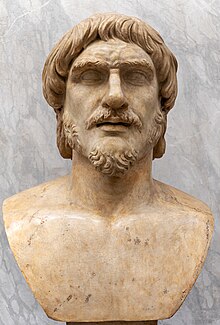Dacians
The Dacians were a people related to the Thracians who had lived since the 5th century BC. BC the areas of the western Black Sea area , the Carpathian Mountains in today's Romania , populated.
Origin and rule
They were related to the neighboring Geten and are said to have had the same language as them. Only from the 1st century BC Both tribes were completely united under Burebista in the Dacian Empire and also expanded into the Carpathian Mountains , moving their center of power from Argedava (west of Bucharest, Romania) further north to Sarmizegetusa on the middle course of the Danube . In the year 60/59 BC They subjugated the Boier and Taurisker and attacked the Greek city of Olbia on the Black Sea.
After the subjugation of Trajan , the Roman province ( Dacia ) essentially comprised the area they inhabited. The province extended beyond the territory of today's Romania and included parts of the Pannonian Plain in the west (in today's Hungary and northern Serbia ) and parts of Moldova and Bulgaria in the east . Historians derive the origin of the Romanians from the Dacians via the Daco Romans .
Tacitus saw in the Dacians "an always unreliable people".
history


- In the period around 50 BC Under King Burebista , a first large Dacian empire emerged from the many small Dacian empires, with a focus on today's Transylvania . In the west it reached as far as Moravia , where it subjugated some Celtic tribes , in the east as far as the Black Sea and the Bug and in the south as far as the Balkan Mountains.
- In 44 BC BC Burebista was murdered and his empire was divided into five parts.
- 29 BC As an ally of Mark Antony, the Dacians were defeated against Octavian , the later Emperor Augustus.
- 16 BC The Dacians invaded Pannonia across the frozen Danube , but were defeated by Emperor Augustus and forced to recognize Roman supremacy.
- After the Romanization of the surrounding areas, a friendship with Rome developed.
- In 85 AD, a Dacian tribe, whose territory lay on the Roman border, invaded the Roman province of Moesia (on the territory of today's Bulgaria and Serbia) under the leadership of Diurparneus . Roman troops were then moved from the Rhine to the province of Moesia (2000 km route); at the same time the Roman war against the Chatti at Colonia ( Cologne ) was stopped.
- In AD 86 the Dacian tribes were united for the last time under the Dacian king Decebalus .
- Emperor Domitian ordered a campaign against Sarmizegetusa, capital of the Dacian empire united under Decebalus and its seat, which was not continued due to the onset of winter and political power struggles.
- On the borders of the province of Pannonia , the Marcomanni and the Jazygens rose against Rome. In order to forestall the unification of these warring parties with the enemy Dacians and thus a closed enemy front from the Danube to the Black Sea, Domitian concluded a peace treaty with Decebalus in 89 AD. Dacia became a vassal state of Rome and received construction aid in the form of money and Roman craftsmen and architects.
- After Domitian's death in 96 AD, this peace was seen as a tremendous disgrace. That is why Emperor Trajan declared war on Decebalus, king of the Dacians, in AD 101.
- In 102 this war ended with a renewed peace treaty, combined with land ceding of Dacia to the Roman Empire.
- However, after Trajan's departure, Decebalus re-armed and began looking for allies. This led to the Second Dacian War (105-106) in the course of which Dacia was defeated and the Roman province of Dacia was created. Decebalus, like many of his compatriots and his generals, committed suicide after he failed to escape.
- Sarmizegetusa was destroyed after the Roman conquest. 40 km from the place of origin they built a new city, which became the capital of the now Roman province of Dacia as Colonia Ulpia Traiana Sarmizegetusa .
- Trajan returned with 330 tons of gold , 165 tons of silver and 50,000 prisoners . Thus he was able to solve Rome's fatal financial problems. Trajan's victory over the Dacians was depicted in Rome, along with other successes, on the Trajan's Column . He also wrote a diary about the Dacian Wars, but it was lost.
literature
- Horst Callies : Dacia. In: Reallexikon der Germanischen Altertumskunde (RGA). 2nd Edition. Volume 5, Walter de Gruyter, Berlin / New York 1984, ISBN 3-11-009635-8 , pp. 185-189.
- Dumitru Berciu: Daco-Romania . - Archaeologia Mundi, Heyne, Munich 1981, ISBN 3-453-35028-6 .
- Peter Wilcox, Gerry Embleton: Rome's Enemies 1. Germanics and Dacians . Osprey, London 1982, ISBN 0-85045-473-5 .
- Maria Munteanu-Barbulescu (arr.): The Dacians. Archeology in Romania. Catalog for the exhibition in the Roman-Germanic Museum from July 8 to September 15, 1980. Zabern, Mainz 1980, ISBN 3-8053-0457-9 .
- I Daci. Catalog for the exhibition Florence 1997. Electa, Milan 1997. ISBN 88-435-6018-2 .
- Johannes Kramer: Dakoi, Dakia. In: The New Pauly (DNP). Volume 3, Metzler, Stuttgart 1997, ISBN 3-476-01473-8 , Sp. 277-280.
- Kai Brodersen : Dacia Felix. Ancient Romania in the focus of cultures . wbg Philipp von Zabern, Darmstadt 2020, ISBN 978-3-8053-5059-4 .
Web links
Individual evidence
- ↑ Tacitus, Historien 3,46,2.

